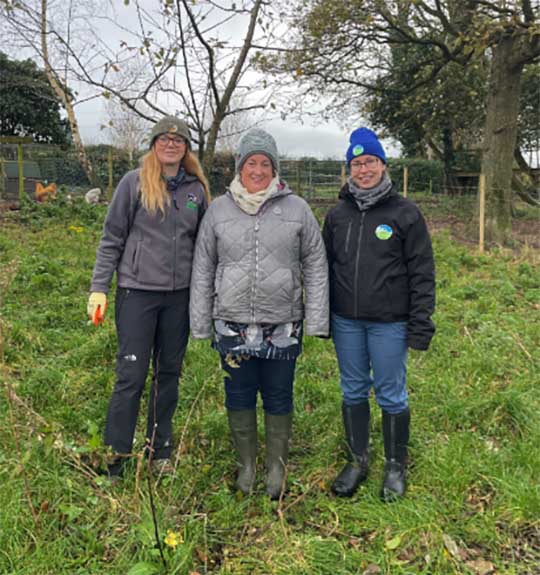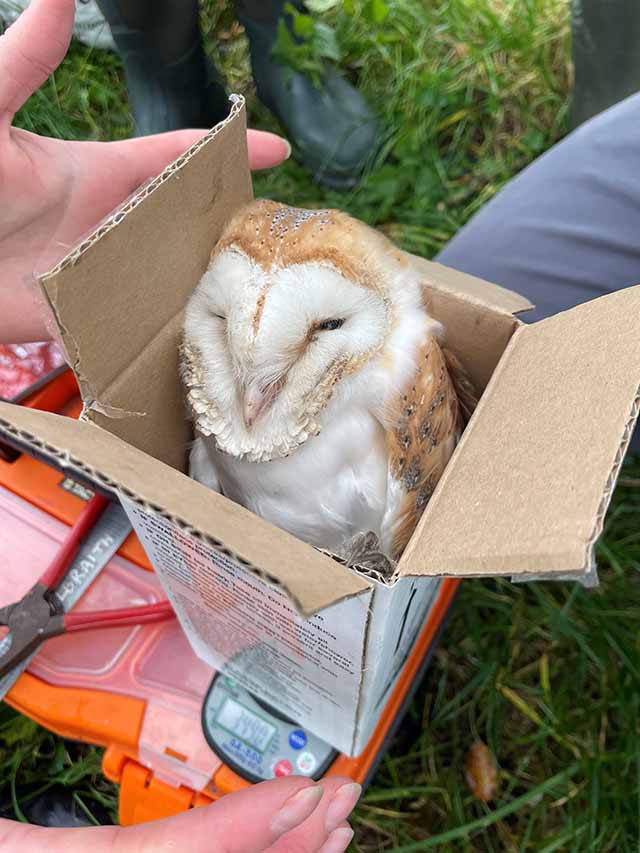Ballycruttle barn owls defy odds with surprise winter brood
A pair of barn owls in Co Down, just a few miles outside Downpatrick, have welcomed an extremely late winter brood, one of the latest recorded in Northern Ireland to date.
The discovery of four fluffy chicks in November has surprised and shocked conservationists from Ulster Wildlife, who inspected the nest site at Ballycruttle Farm under licence from NIEA.
The chicks, which fledged in December, are one of the latest broods the local nature conservation charity has encountered in its work to protect these threatened farmland birds over the last 10 years.
In Northern Ireland, barn owl eggs are typically laid in April, with chicks normally fledging in June or July, occasionally later depending on the weather, but this brood has bucked the trend.
“When Dawn, the landowner at Ballycruttle Farm, sent me an audio recording of chicks snoring and rasping in late October, I couldn’t believe it.
“It was so late in the season,” said Katy Bell, Senior Conservation Officer from Ulster Wildlife.

“A visit confirmed the exciting news, but our main concern was whether the chicks would survive given the extremely wet weather and floods.
“Barn owls struggle to hunt in wet conditions, but thankfully the odds were in their favour, as small mammals were fleeing to safety providing easy prey.
“On our return a few weeks later, we were ecstatic to ring four healthy chicks alongside BTO and RSPB NI. This is the second consecutive year barn owls have bred at Ballycruttle Farm.
“It is a real testament to their wildlife-rich habitats and practices,” she added.
However, the Ballycruttle barn owl pair had their fair share of drama before raising their latest brood.
In March, jackdaws took up residence in their nest box, which resulted in the female moving away to a nearby farm, managed by the Kelly family.
A single male had been hunting on the Kelly’s nature-friendly farm for many years and, to their delight, the pair bred and fledged one chick in late summer.
But the Ballycruttle male barn owl persisted. He kept calling and calling to woo the female back.
Eventually, she conceded and left her one chick in the hands of the male, who continued to keep feeding it and laid another clutch of eggs in her original box at Ballycruttle Farm.
“It was like a soap opera with all the twists and nail-biting moments,” said Dawn Stocking, from Ballycruttle Farm.
“I was, of course, disappointed when the female jumped ship to my neighbour’s fantastic farm and thought that we weren’t going to see any chicks at Ballycruttle this year at all.

“So, you can imagine my utter excitement when I heard babies snoring from the nest box – it was like Christmas had come early!
“We set up a couple of wildlife cameras nearby to watch their antics, and what an experience it has been.
“We saw an adult dropping food and the scramble from the chicks, and wing stretches and small hops.
“We also heard the young calling to their parents and witnessed their first flights. It has been absolutely magical.”
Ballycruttle Farm and Kelly’s Farm are part of the County Down Farmland Bird Initiative.
This is a group project within the Environmental Farming Scheme, led by RSPB NI. RSPB NI and has been working with both nature-friendly farms and Ulster Wildlife for many years to halt and reverse the decline of the iconic barn owl.
To date, there are fewer than 30 breeding pairs estimated to be left in Northern Ireland.
Michelle Duggan, Conservation Officer at RSPB NI, said: “It is a delight to see the continued hard work carried out by both nature-friendly farms yield positive results for barn owls, as well as creating a network of habitats between the two sites.
“The valuable seed-rich habitats maintained on both farms are an essential winter food source for the endangered yellowhammer, and also ideal hunting territory for barn owls to catch small mammal prey. Healthy hedgerows combined with areas of rough grassland allow barn owls to expand their hunting territory even further.”
The chicks were ringed by licensed BTO bird ringers, David Galbraith and Stephen Fyffe, to help identify and track the birds’ movement. Strict hygiene procedures were followed to reduce possible transmission of Avian Influenza.
If you have land suitable for barn owls or want advice on how to create wildlife-friendly habitat, Ulster Wildlife has produced a guidance document on ‘Improving Land for Barn Owls’ – available at:
www.ulsterwildlife.org/barn-owls.
If you have seen a barn owl or would like to discuss measures you can put in place to help them, please contact Katy Bell at Ulster Wildlife on 07816 065 736 or email:
Check Out About Barn Owls at:
www.ulsterwildlife.org/barn-owls
- The barn owl is one of Northern Ireland’s rarest and endangered birds, red-listed on the Irish Birds of Conservation Concern and protected under the Wildlife (NI) Order 1985.
- It is illegal to look in barn owl nest boxes, photograph or film their nest without a special licence.
- Barn owls don’t make nests. They nest in old buildings, hollow tree trunks or occasionally nest boxes.
- Pairs will use the same location to breed every year.
- The barn owl is nocturnal and hunts mainly at dawn and dusk.
- Its preferred hunting habitat is rough, ungrazed grassland.
- It is silent in flight but is often referred to as the ‘screech owl’ due to the ear-splitting sound it can emit.
- Its efficiency in eating small mammals, such as mice and shrews, has earned it the nickname ‘the farmer’s friend.’























